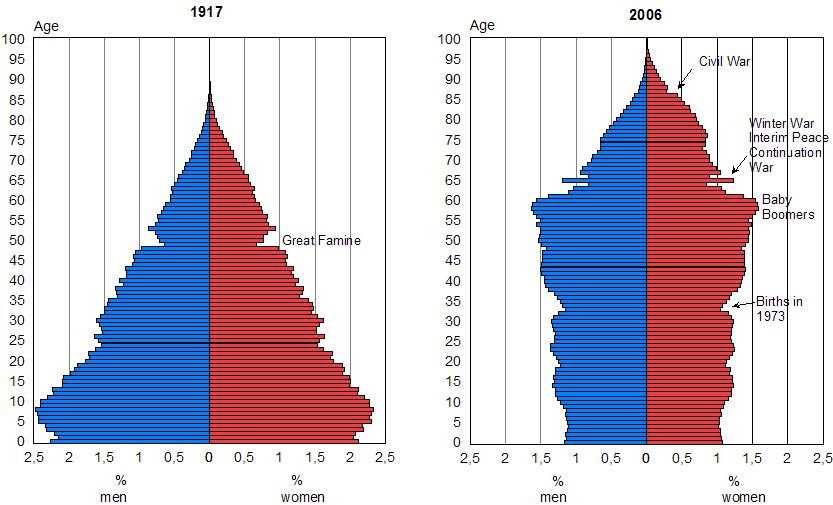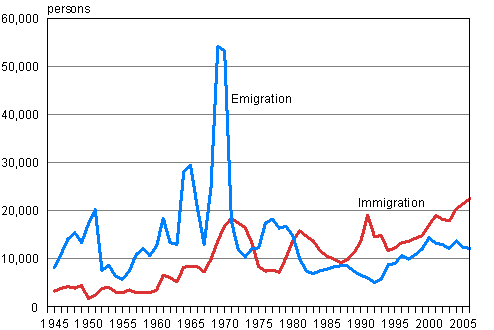Population development in independent Finland - greying Baby Boomers
Nearly 32,000 persons who were born when Finland was a Grand Duchy of Russia still live in Finland today. The vast majority of 80 per cent of them are women. Seventeen of the 200 children who were born on 6 December 1917 are still alive and celebrate their 90th birthday on the same day as Finland celebrates the 90th anniversary of her independence.
When Finland declared independence in 1917, her population totalled 3.1 million. The landmark of three million had been exceeded a couple of years earlier. The Civil War of 1918 made the first year of independence one of the bloodiest in Finland's history. Inclusive of those killed in action, executed, or perished in prison camps, a total of 95,000 persons - the highest number ever in a single year during Finland's independence - died in 1918.
In consequence of the exceptional circumstances of the 1918 war, the number of children born in 1919 was considerably down on previous years. The number of births went up in the following years but population growth was slowed down by increasing emigration in the 1920s.
In the 1930s, concerns were already voiced about the future of Finland's population. According to the first population projection made in 1934 by what was then known as the Central Statistical Office, the size of Finland's population would never exceed four million. However, history has proved otherwise: the four million mark was passed in 1950 and the five million mark in 1991 (Table1). At the moment Finland's population seems unlikely to ever exceed six million - but this, again, is just a projection.
Table 1. Size of population 1912-2006
| Year | Population | Population growth (%) |
| 1912 | 3,015,500 | 1.2 |
| 1917 | 3,134,300 | 0.6 |
| 1950 | 4,029,803 | 1.0 |
| 1991 | 5,029,002 | 0.6 |
| 2006 | 5,276,955 | 0.4 |
Population growth peaked after Wold War II
The Second World War changed the direction of population growth. After the Winter War, the number of births fell in 1940, but then went up again in the next year of Interim Peace. Once the war was over, the number of births reached peak figures. The all-time record month was September 1945 when over 12,000 children were born. The annual record was made in 1947 with 108,168 births. In 1947 the total fertility rate, in other words, average number of births per woman, was 3.5.
After the peak year, the fertility rate started to fall little by little. It was at its lowest in 1973 when the total fertility rate stood at 1.5 and under 57,000 children were born. The rate then went up somewhat and has remained almost unchanged for the past three decades. In 2006, the total fertility rate was 1.8 and almost 59,000 children were born.
Population pyramid mirrors history
Population pyramids can be used to study population development. The population pyramid of 1917 still looks like a pyramid and is typical for a country with a high fertility rate. At that time, children aged 0 to 14 made up 35 per cent of the population, whereas today their share of the population is 17 per cent. The small cohorts born during the Great Famine of 1866-1868 can still be seen as a small indentation in the upper half of the pyramid.
Figure 1. Age structure of population in 1917 and 2006

The 2006 population pyramid reflects the history of population development during Finland's independence. Remnants of the small generation left as a legacy from the 1918 Civil War can still be seen at the top. The ending of the unstable years of the Second World War is followed by the birth of the Baby Boomers. The birth rate kept falling from the 1950s right up to the early 1970s. Since then, born generations have been almost identical in size right up to today.
Lengthening life expectancy
Over the 90 years of independence, the standard of living in Finland has risen considerably and in consequence brought the mortality rate down year by year. While the statistical life expectancies of men and women born in Finland towards the late 1910s were 43 years and 49 years, the respective life expectancies have today risen to 76 years for men and 83 years for women. However, the difference between the life expectancies of men and women has grown during the years of independence.
The rate of mortality among children under the age of 12 months has also declined enormously in nine decades. When Finland gained independence, one child in ten in the country died in their first year of life, whereas today the infant mortality rate is under 0.5 per cent. Although the growth in life expectancy is not among the very highest in the world in Finland, the country's infant mortality rate is one of the lowest in the world.
Rapid depopulation of countryside
After the Second World War Finland was still a typical agrarian society. In 1950, agriculture provided livelihood for 46 per cent of the economically active population while one-third of the population lived in urban towns. From then on, the industrial structure changed rapidly. Manufacturing, trade and diverse services generated new jobs and migration from rural areas to population centres livened up. At the same time, the fertility rate also began to decline, which partly contributed to the depopulation of the countryside.
The entry of the Baby Boomers on the labour market in the 1960s and 1970s accelerated migration into towns and population centres even further. Internal migration peaked in 1974 when approximately 276,000 persons, or six per cent of the population, changed their municipality of residence. Internal migration did not match this volume until the 2000s, by which time Finland's population had grown by over half-a-million persons.
Eagerly abroad
Towards the end of the 1800s, large numbers of people were already leaving Finland to live abroad. In the immediate years after independence Canada and the United States attracted thousands of people. Emigration slowed down in the 1930s, but livened up again immediately after the Second World War, especially to Sweden.
When the Baby Boomers reached working age in the 1960s, the labour market in Finland was unable to respond to the rapidly grown supply of labour. Sweden attracted Finnish emigrants because the highly automated manufacturing industry in Sweden was able to employ even immigrants who could not speak Swedish.
Hundreds of thousands of Finns emigrated to Sweden in the 1960s and 1970s. However, some of them returned. In 1969 and 1970, emigration was so lively that it reduced Finland's population. Prior to this the size of the country's population last contracted in 1940 and the reason then was the war.
A minor wave of emigration was still experienced in the 1970s but it then gradually died down. Since 1980, immigration into Finland has exceeded emigration from the country.
Immigration livens up in the 1990s
Finland has not attracted much immigration. The Baby Boomers have ensured plentiful supply of labour and unlike Sweden and Germany Finland has so far not needed foreign labour.
Compared to other countries, foreigners have made up a very small proportion of the total population in Finland. As late as in the early 1990s, only one per cent of all people living in Finland were foreign nationals. However, their number began to grow rapidly from there on - by the Finnish yardstick. In the 1990s, both Ingrian remigrants and a record number of asylum seekers arrived in Finland. At the end of 2006, foreign nationals made up 2.3 per cent of the whole population.
Figure 2. Migration in 1945-2006

A total of 121,739 foreign nationals lived in Finland at the end of 2006. They came form 174 countries, in other words, nearly all countries of the world, and spoke 138 different languages.
Finland's population is greying - labour shortage looms
On the 90th anniversary of her independence Finland has the world's fastest ageing population. The Baby Boomers are retiring, and the lengthened life expectancy will increase the size of the elderly population in the coming years. The effects from the population development that has gone on for decades are now becoming visible: because the fertility rate has already stayed below the reproduction rate for a generation, more people are exiting working age than entering it. The diminished supply of labour will inadvertently lead to labour shortage.
As matters stand, the shortage of labour can only be solved by attracting labour from abroad. Otherwise the inescapable consequences will be reduced labour force and declining economy. There will not be enough tax payers to sustain the rapidly rising number of pensioners. The growth in the number of elderly people not only means risen pension expenditure but also increased need for health care and other services. How the future will shape up will largely depend on the development of immigration into Finland.
Inquiries: Mr Mauri Nieminen +358 9 1734 3255
Sources and links
- Population Statistics
- Module of eCourse in Statistics on Demography and Population Statistics
Last updated 5.12.2007
